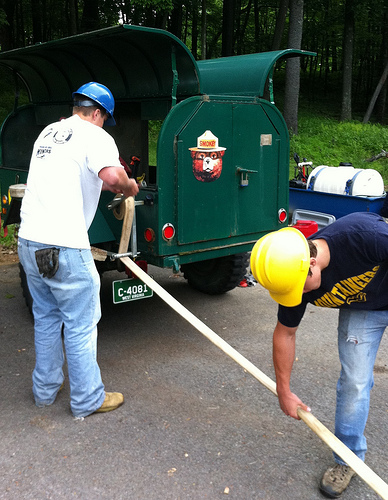Today I hosted my very first twitter chat. Seeing all the conversations fly by in real-time on Tweetdeck was overwhelming at first but I quickly got the hang of it. I was happy to see so many tweeters send questions to our @USDA Twitter account for me to answer. I really hope that the chat was informative and interesting to all of you who participated. It certainly was for me!
As a mom, grandmother and someone who spent many valuable years working in schools, I understand—first-hand—the great feedback that people provided. There are challenges in meeting the needs of growing children, and I believe the improvements we’ve made to school meals will go a long way toward meeting those challenges. I’m proud of what we’ve been able to do so far. Read more »
The USDA Market News Division of the Agricultural Marketing Service (AMS) works with various processors, buyers and brokers to track a wide variety of commodities. Since September 2010, USDA Market News has been reporting apple juice concentrate (AJC) prices as part of the National Apple Processing Report. This report also includes information on prices for apple varieties, shipments, and quantities utilized in the processing of apples on a weekly and yearly basis.
The Minneapolis Grain Exchange, a Designated Contract Market and Derivatives Clearing Organization, announced the official launch date for its new apple juice concentrate futures and options contract on August 13, 2012. The exchange developed the apple juice concentrate contract after thorough preparation and collaboration with many segments representing the apple juice industry as well as USDA, AMS, Fruit and Vegetable Market News. Read more »
One of the most frequent questions I receive at the National Agricultural Statistics Service (NASS) is, “How can we accurately forecast agricultural production?” After all, anyone in the agriculture industry knows that regardless of how accurate you are, every year the weather can wreak havoc on any forecasts. This is why NASS doesn’t simply rely on formulas when we prepare our forecasts. Our data incorporate input from hundreds of thousands of farmers and ranchers across the United States.
The past few years have given us a great opportunity to highlight the importance of farmer surveys. Last year, producers were battered by some of the most significant floods on record, which were followed by a summer that broke several heat records. Although many crops were affected, one result was that U.S. growers produced significantly less wheat. North Dakota farmers, the nation’s leading Durum wheat growers, planted a record-low number of acres in 2011. If farmers themselves didn’t report this information to us, there would be no other way NASS could accurately estimate the results of such an unusual year. Read more »
As a new school year begins, I’m proud to say that the Obama Administration is taking historic steps to make the school day healthier for kids in schools across the country. I’m excited about the changes showing up in cafeterias this school year – more fruits, vegetables and whole grains; low-fat and fat-free milk choices; and fewer salty and fatty foods.
In addition to those changes, the U.S. Department of Agriculture is working with parents, teachers and school cafeteria managers to ensure our kids get the right amount of food. Menus are planned for grades K-5, 6-8 and 9-12 and the meals are “right-sized” so that kids get the appropriate amount of calories and the correct portions of different foods. To further improve menu changes, we’re increasing the focus on reducing the amounts of sodium, saturated fat and trans fats available in those meals. Read more »

Ladysmith Service Center employees with a Feds Feed Families donation. Left to right Rick Cote (FSA PT) – Sandy Voldberg(FSA-PT) – Mike Koehler(NRCS-DC) – Kathy Brihn(FSA-CED)
At over 1,600 field offices across the country, USDA employees are playing their part to help reach our 2012 Feds Feed Families goal of 1.8 million pounds of food. Feds Feeds Families seeks to help local food banks and pantries provide for their communities over the summer months—a time of year characterized by increased need and decreased giving. We are in the final month of this year’s drive and it is more important than ever to stay motivated to both reach our goal and help our neighbors in need. Read more »

Wildland firefighter trainees windup a fire hose.
With fires raging across the Western states dramatic images of wildland firefighters attempting to contain the flames are a regular visual in newspapers and on TV and computer devices across the country. These striking visuals rouse the fighter in some of us and we might ask: Can I fight a wildfire?
The answer is you can—if you meet certain criteria. Both federal and state agencies have varying requirements to award what is referred to as a Wildfire Qualification Card. Like a driver’s license, this card says you’re certified to fight wildland fires. So how do you get one? Aside from hours of online testing, you’ll have to enroll in a week long fire training-type boot camp where you’ll take more tests and be given a large spiral bound book called the Fireland Handbook. Read more »


